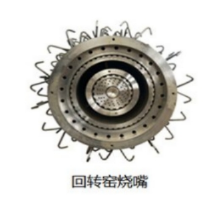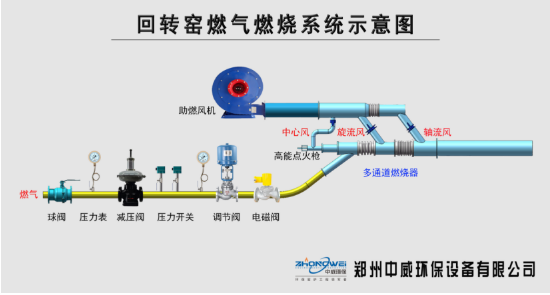
Hotline 0371-60960056

Hotline 0371-60960056
 Pubtime:2023-04-27 16:28:15
Pubtime:2023-04-27 16:28:15
 Views:21
Views:21
 Source:Network
Source:Network
The four channel gas burner is a newly developed new type of combustion device. Our company adopts advanced technology both domestically and internationally to design and manufacture a four channel gas burner, specifically designed for burning gas fuel in rotary kilns. Its unique structure and reasonable process parameters ensure sufficient mixing of gas fuel with air, primary and secondary air, high thermal intensity, high combustion efficiency, and convenient adjustment. At present, it has been widely used in rotary kilns in metallurgy, oxidized pellets, ceramic sand, magnesium oxide, and chemical industries, and has been proven by multiple manufacturers to have better performance than the original burner.
principle
As shown in the figure, gas fuel is swirled outward from the gas pipeline at a certain diffusion angle, and is transmitted to a considerable amount of momentum and moment of momentum by the neighboring swirling wind. It spirals forward at high speed and continues to diffuse radially, meeting the high-speed axial flow wind beam. The insertion of an axial flow wind beam further enhances the mixing of gas fuel and air (including the surrounding secondary air), and can adjust the degree of flame divergence. It can adjust the length and thickness of the flame as needed to achieve the desired flame shape. The role of the central wind is to promote the combustion of a small amount of gas fuel and C0 in the central part, making the combustion more complete and playing a stabilizing role. Due to this combustion mechanism and the high speed of swirling and axial air, the combustion speed and efficiency are ensured.

Flow diagram of gas burner
As shown in the figure, it is composed of pipelines, nozzles, ignition devices, metal ripple compensators, butterfly valves, pressure measuring instruments, and protective layers.
Pipeline: It is divided into five parts from the outside to the inside, namely axial flow air duct, gas fuel air duct, vortex air duct, internal axial flow air duct, central air duct, and ignition channel. Due to the fact that the ignition channel is only used during ignition, it is commonly referred to as the five channels.
Nozzles: Made of special materials, the nozzle area of each pipeline can be adjusted to adjust the wind speed, which is one of the key components to ensure the shape and lifespan of the flame.
Ignition device: located in the central wind channel, used for automatic ignition.
Metal corrugated compensator: It is the main component that connects various pipelines, seals and adjusts the shape of the flame, allowing axial movement of the connected pipelines.
Butterfly valve: used to regulate air volume. This burner is equipped with a butterfly valve, which is used to regulate the flow of central air, vortex air, internal axial air, and external axial air. There is a manual butterfly valve in the ignition section to regulate the flow of pilot gas.
Pressure measuring instrument: indirectly displays the spray speed of the air outlet inside the burner. Protective layer: refers to the refractory pouring layer, which is the responsibility of the user for pouring.

Some of the content and pictures are extracted from the Internet. Please contact us for deletion if there is any infringement.